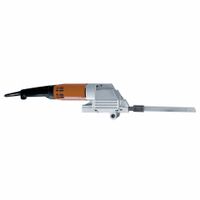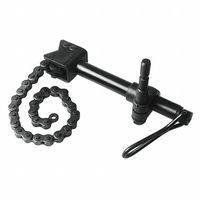Call +(254) 703 030 000 / 751 483 999 / 721 704 777
- Home
- Tools
- Power Tools
- Power Saws Blades
- Power Hacksaws
.....Read More
Frequently Asked Questions
What is a power hacksaw used for?
A power hacksaw is a mechanical device used for cutting materials, primarily metals, with precision and efficiency. It is designed to automate the manual process of sawing, providing consistent and accurate cuts with less physical effort. The power hacksaw consists of a motor-driven mechanism that moves a blade back and forth in a reciprocating motion, similar to a manual hacksaw but with greater speed and force.
The primary use of a power hacksaw is in metalworking and fabrication shops where it is employed to cut through various types of metal bars, rods, pipes, and profiles. It is particularly useful for cutting hard materials that would be difficult or time-consuming to cut manually. The machine can handle a range of materials, including steel, aluminum, and other alloys, making it versatile for different industrial applications.
Power hacksaws are favored for their ability to produce straight and clean cuts, which is essential in manufacturing processes where precision is critical. They are often used in the initial stages of production to cut raw materials to the required lengths before further processing or assembly. Additionally, power hacksaws are used in maintenance and repair operations where quick and accurate cutting is necessary.
The machine's design allows for adjustable cutting speeds and feed rates, enabling operators to optimize the cutting process for different materials and thicknesses. Safety features, such as blade guards and automatic shut-off mechanisms, are typically included to protect operators during use.
Overall, a power hacksaw is an essential tool in industrial settings, providing efficiency, accuracy, and safety in cutting operations.
How does a power hacksaw work?
A power hacksaw is a mechanical device used to cut materials, typically metal, with precision and efficiency. It operates using a motor-driven mechanism that automates the cutting process, reducing manual effort and increasing productivity.
The core component of a power hacksaw is the saw blade, which is a straight, toothed blade designed to cut through metal. The blade is mounted on a reciprocating arm that moves back and forth in a linear motion. This reciprocating action is powered by an electric motor, which is connected to a crank or cam mechanism that converts the motor's rotary motion into the linear motion required for cutting.
When the power hacksaw is activated, the motor drives the crank mechanism, causing the saw blade to move in a reciprocating motion. As the blade moves forward, it cuts into the material, and on the return stroke, it lifts slightly to reduce friction and wear. This cycle repeats rapidly, allowing the blade to progressively cut through the material.
The workpiece is typically clamped securely in a vice or fixture on the machine's base to ensure stability during cutting. The operator can adjust the feed rate and cutting speed according to the material's hardness and thickness, optimizing the cutting process for efficiency and accuracy.
Some power hacksaws are equipped with a coolant system that sprays a lubricating fluid onto the blade and workpiece, reducing heat and friction, prolonging blade life, and improving the quality of the cut.
Overall, a power hacksaw is an essential tool in workshops and industrial settings, providing a reliable and automated solution for cutting metal and other hard materials with precision.
What materials can a power hacksaw cut?
A power hacksaw is a versatile cutting tool used primarily for cutting metal, but it can handle a variety of materials depending on the blade used. Here are the materials a power hacksaw can cut:
1. **Metals**:
- **Steel**: Including mild steel, stainless steel, and alloy steels.
- **Aluminum**: Soft and lightweight, easily cut with appropriate blades.
- **Copper and Brass**: Non-ferrous metals that are softer and easier to cut.
- **Cast Iron**: Requires a robust blade due to its hardness and brittleness.
2. **Plastics**:
- **PVC and Acrylic**: Commonly used plastics that can be cut with a fine-toothed blade to prevent chipping.
- **Polycarbonate**: Requires careful cutting to avoid cracking.
3. **Wood**:
- Although not the primary use, a power hacksaw can cut wood with the right blade, typically for rough cuts.
4. **Composites**:
- **Fiberglass and Carbon Fiber**: Can be cut with specialized blades designed to handle the abrasive nature of these materials.
5. **Rubber**:
- Soft rubber materials can be cut, but care must be taken to avoid binding.
The effectiveness of cutting these materials depends on selecting the correct blade type, tooth count, and material. Blades with fewer teeth per inch (TPI) are suitable for softer materials, while more TPI is ideal for harder materials. Proper lubrication and cooling are also essential to prevent overheating and ensure a clean cut.
What is the difference between a power hacksaw and a reciprocating saw?
A power hacksaw and a reciprocating saw are both tools used for cutting, but they differ in design, operation, and applications.
A power hacksaw is a stationary machine tool designed for cutting metal. It uses a straight, toothed blade that moves back and forth in a horizontal motion. The workpiece is clamped in place, and the blade is driven by an electric motor. Power hacksaws are typically used in workshops or industrial settings for cutting large metal bars, pipes, or profiles. They provide precise, straight cuts and are ideal for repetitive tasks. The cutting speed and pressure can often be adjusted to suit different materials and thicknesses.
In contrast, a reciprocating saw is a handheld, portable tool that can cut through a variety of materials, including wood, metal, and plastic. It also uses a straight blade that moves in a back-and-forth motion, but it is designed for versatility and mobility. Reciprocating saws are commonly used in construction, demolition, and remodeling projects. They are ideal for cutting in tight spaces or awkward angles and can make both straight and curved cuts. The blades are easily interchangeable, allowing the tool to adapt to different materials and tasks.
In summary, the main differences lie in their design and application: power hacksaws are stationary and used for precise, repetitive metal cutting, while reciprocating saws are portable and versatile, suitable for a wide range of materials and cutting tasks.
How do you maintain a power hacksaw?
To maintain a power hacksaw, follow these steps:
1. **Regular Cleaning**: After each use, clean the machine to remove metal shavings, dust, and debris. Use a brush or compressed air to clean hard-to-reach areas.
2. **Blade Inspection and Replacement**: Regularly inspect the blade for wear, damage, or dullness. Replace the blade if it shows signs of wear or if it becomes dull to ensure efficient cutting and prevent damage to the machine.
3. **Lubrication**: Ensure all moving parts are well-lubricated to reduce friction and wear. Use the manufacturer-recommended lubricant for the blade guides, pivot points, and other moving components.
4. **Check and Adjust Tension**: Regularly check the blade tension. Proper tension is crucial for accurate cuts and to prevent blade breakage. Adjust the tension according to the manufacturer's specifications.
5. **Inspect Electrical Components**: Check the power cord, switches, and other electrical components for signs of wear or damage. Replace any damaged parts to prevent electrical hazards.
6. **Alignment and Calibration**: Periodically check the alignment of the blade and the cutting arm. Ensure they are properly aligned to maintain cutting accuracy. Calibrate the machine as needed.
7. **Coolant System Maintenance**: If the hacksaw uses a coolant system, ensure it is functioning correctly. Check the coolant level and top up if necessary. Clean the coolant tank and replace the coolant periodically to prevent contamination.
8. **Safety Checks**: Regularly inspect safety guards and emergency stop functions to ensure they are operational. Replace or repair any faulty safety features immediately.
9. **Routine Inspection**: Conduct routine inspections of all components, including the frame, motor, and drive mechanisms, to identify and address any potential issues early.
10. **Follow Manufacturer Guidelines**: Always refer to the manufacturer's manual for specific maintenance instructions and adhere to recommended service intervals.
What type of blade is best for cutting metal with a power hacksaw?
A bi-metal blade is best for cutting metal with a power hacksaw. These blades are constructed with two types of metal: a high-speed steel cutting edge and a flexible alloy steel back. This combination provides durability, flexibility, and resistance to heat and wear, making them ideal for cutting through various metals, including steel, aluminum, and other non-ferrous metals. The high-speed steel edge maintains sharpness and cutting efficiency, while the flexible back prevents the blade from breaking under stress.
When selecting a bi-metal blade, consider the tooth count, which is measured in teeth per inch (TPI). A higher TPI, such as 18-32, is suitable for cutting thin metal sheets or tubing, as it provides a smoother cut and reduces the risk of tearing. For thicker metal sections, a lower TPI, such as 10-14, is more effective, as it allows for faster cutting and better chip clearance.
Additionally, the tooth design is crucial. A wavy set or raker set tooth pattern is often preferred for metal cutting, as it helps in reducing friction and heat buildup, ensuring a cleaner cut. The blade length should match the power hacksaw's specifications to ensure proper tension and performance.
Overall, a bi-metal blade with the appropriate TPI and tooth design is the optimal choice for cutting metal with a power hacksaw, offering a balance of precision, durability, and efficiency.
Why is cutting fluid used with power hacksaws?
Cutting fluid is used with power hacksaws primarily to enhance the cutting process and extend the lifespan of both the tool and the workpiece. The main reasons for using cutting fluid include:
1. **Lubrication**: Cutting fluid reduces friction between the saw blade and the material being cut. This lubrication minimizes wear and tear on the blade, allowing for smoother and more efficient cutting. It also helps in maintaining the sharpness of the blade for a longer period.
2. **Cooling**: The cutting process generates significant heat due to friction. Cutting fluid acts as a coolant, dissipating this heat and preventing the blade and workpiece from overheating. Overheating can lead to thermal expansion, which may cause inaccuracies in the cut and potential damage to the material.
3. **Chip Removal**: Cutting fluid aids in the removal of metal chips and debris from the cutting area. By flushing away these particles, the fluid prevents them from getting trapped between the blade and the workpiece, which could otherwise cause scoring or damage to the surface.
4. **Surface Finish**: The use of cutting fluid can improve the surface finish of the cut material. By reducing friction and heat, the fluid helps achieve a cleaner and more precise cut, reducing the need for additional finishing processes.
5. **Corrosion Prevention**: Some cutting fluids contain additives that help protect the workpiece and the saw blade from corrosion. This is particularly important when working with metals that are prone to rust or oxidation.
Overall, cutting fluid is essential in power hacksaw operations to ensure efficiency, precision, and longevity of both the tool and the material being processed.

